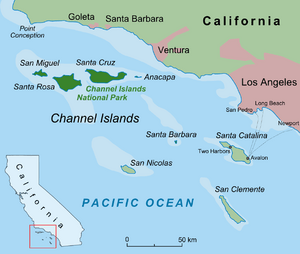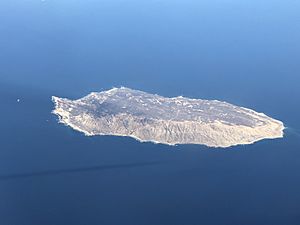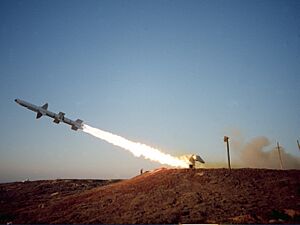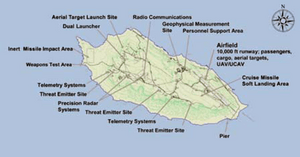San Nicolas Island facts for kids
San Nicolas Island is the most distant of the Channel Islands, located off the coast of Southern California. It is about 61 miles (98 km) from the nearest point on the mainland. This island is part of Ventura County.
The island covers about 14,562 acres (58.93 km2). The United States Navy currently controls it. They use it for testing weapons and for training. The island has a small airport called Naval Outlying Landing Field San Nicolas Island. Even though it's officially uninhabited, about 200 military and civilian staff live there at any time. The island's runway is 10,000 feet long, making it the second longest in Ventura County.
Contents
Island History: A Look Back
People have lived on San Nicolas Island for at least 10,000 years. For thousands of years, the Nicoleño people called it home. They were likely related to the Tongva tribe from the mainland and Santa Catalina Island.
A Spanish explorer named Sebastián Vizcaíno saw the island on December 6, 1602. This day is the feast day for Saint Nicholas, so he named the island after the saint. Later, Russian traders called it Il'men.
In the early 1800s, the Nicoleño people were forced to leave the island by the California mission system. Sadly, within a few years of leaving their home, the Nicoleño people and their unique language disappeared.
The Lone Woman of San Nicolas Island
The most famous person from San Nicolas Island was known as the "Lone Woman." Her real name was Juana Maria. She was accidentally left behind when her people moved to the mainland. She lived alone on the island for 18 years!
In 1853, Captain George Nidever and his crew found her. They took her to Santa Barbara. Her amazing story inspired the famous children's book Island of the Blue Dolphins by Scott O'Dell.
San Nicolas Island and the Military
San Nicolas Island was once considered as a place to test the first atomic bomb. However, another location was chosen instead.
From 1957 to 1973, and again in 2004 and 2010, the U.S. military launched research rockets from the island. It is still part of the Pacific Missile Range.
Today, San Nicolas Island is a part of Naval Base Ventura County. It is owned and operated by the U.S. Navy. The island has a long runway, communication tools, and areas for launching missiles and targets. There are even mock cities used for urban warfare training.
Island Geography
The highest point on San Nicolas Island is Jackson Hill. It stands 907 feet above sea level.
How the Island Was Formed
The island is mostly made of sandstone and shale rocks. These rocks formed a very long time ago. There are also deposits from ancient ocean terraces, which means the island was likely completely underwater at one point.
The western part of the island is covered with reddish-brown sand dunes. These dunes were formed by wind and can be over 10 meters deep in some areas. Small amounts of volcanic rocks can be found on the southeast side of the island.
The native people used hard rocks like quartzite for making tools. These rocks were found as pebbles within other rock formations.
Island Climate and Weather
San Nicolas Island has a semi-arid climate, which means it's quite dry. It also has features of a Mediterranean climate.
Winters are mild, with an average temperature of about 55.3°F (12.9°C) in February. Most of the rain falls during winter. Summers are dry and warm, with an average of 64.7°F (18.2°C) in September. Temperatures rarely go above 90°F (32°C). The island gets about 8.58 inches (218 mm) of rain each year. February is usually the wettest month, and August is the driest. On average, it rains about 36 days a year.
| Climate data for San Nicolas Island | |||||||||||||
|---|---|---|---|---|---|---|---|---|---|---|---|---|---|
| Month | Jan | Feb | Mar | Apr | May | Jun | Jul | Aug | Sep | Oct | Nov | Dec | Year |
| Record high °F (°C) | 83 (28) |
83 (28) |
78 (26) |
96 (36) |
100 (38) |
91 (33) |
91 (33) |
95 (35) |
103 (39) |
100 (38) |
88 (31) |
82 (28) |
103 (39) |
| Mean daily maximum °F (°C) | 61.3 (16.3) |
60.5 (15.8) |
61.2 (16.2) |
63.2 (17.3) |
64.7 (18.2) |
66.3 (19.1) |
69.1 (20.6) |
70.7 (21.5) |
71.1 (21.7) |
69.7 (20.9) |
66.5 (19.2) |
62.4 (16.9) |
65.6 (18.7) |
| Daily mean °F (°C) | 55.6 (13.1) |
55.3 (12.9) |
56.0 (13.3) |
56.9 (13.8) |
58.9 (14.9) |
60.4 (15.8) |
62.9 (17.2) |
64.3 (17.9) |
64.7 (18.2) |
63.2 (17.3) |
60.5 (15.8) |
57.1 (13.9) |
59.6 (15.3) |
| Mean daily minimum °F (°C) | 50.1 (10.1) |
50.2 (10.1) |
50.6 (10.3) |
50.7 (10.4) |
53.0 (11.7) |
54.5 (12.5) |
56.6 (13.7) |
57.9 (14.4) |
58.4 (14.7) |
56.7 (13.7) |
54.5 (12.5) |
51.8 (11.0) |
53.7 (12.1) |
| Record low °F (°C) | 36 (2) |
37 (3) |
38 (3) |
40 (4) |
41 (5) |
47 (8) |
44 (7) |
46 (8) |
48 (9) |
40 (4) |
42 (6) |
38 (3) |
36 (2) |
| Average precipitation inches (mm) | 1.67 (42) |
2.00 (51) |
1.34 (34) |
0.58 (15) |
0.05 (1.3) |
0.02 (0.51) |
0.01 (0.25) |
0.06 (1.5) |
0.17 (4.3) |
0.26 (6.6) |
0.58 (15) |
1.84 (47) |
8.58 (218) |
| Average precipitation days (≥ 0.01 in) | 6 | 7 | 4 | 5 | 3 | 1 | 1 | 0 | 1 | 2 | 3 | 6 | 36 |
| Source: WRCC (normals 1933–1976) | |||||||||||||
Plants and Animals of San Nicolas Island
San Nicolas Island doesn't have a huge variety of plants and animals. The island was heavily grazed by sheep until 1943. This grazing and erosion removed much of the rich topsoil.
Island Plants (Flora)
Despite the damage, three plants are found only on this island. These are Astragalus traskiae, Eriogonum grande subspecies timorum, and Lomatium insulare.
The main plant type on the island is coastal scrubland. You can often see giant coreopsis and coyote brush. The few trees, like California fan palms, were brought to the island more recently. However, old records show that before 1860, parts of the island were covered in brush.
The island also has special "biological soil crusts." These are living layers on the soil surface, protected because there are no grazing animals. Scientists are finding many unique types of algae and cyanobacteria (blue-green algae) on the island.
Island Animals (Fauna)
Only three types of land animals that have backbones are native to the island. These are the island night lizard (Xantusia riversiana), the deer mouse (Peromyscus maniculatus exterus), and the island fox (Urocyon littoralis dickeyi). Other lizards like the common side-blotched lizard and southern alligator lizard were likely brought to the island more recently.
Many birds live on San Nicolas Island. Two important bird species are the western gull and Brandt's cormorant. These birds are sometimes threatened by the island foxes.
Protecting Island Wildlife
One of the biggest threats to the island's wildlife used to be the common housecat. These cats hunted cormorants, gulls, and the island night lizard. They also competed with the native Island fox. The cats likely arrived on the island before 1952, brought by Navy officers.
In 2009, the U.S. Navy, with help from groups like Island Conservation and the Humane Society of the United States, removed all the cats from the island. The cats were moved to a special new home in Ramona. In 2012, the island was officially declared free of cats. This effort took 18 months and cost $3 million.
Channel Islands Restoration (CIR) works with the U.S. Navy on projects to restore the island. They have rebuilt a native plant nursery. CIR also removes harmful invasive plants, like Sahara mustard, which threatens native plants. They have also helped restore the habitat for the San Nicolas Night Lizard by planting prickly pear cactus. This has helped the lizard populations grow. This night lizard is found on only three of the Channel Islands and was recently removed from the endangered species list thanks to these conservation efforts.
See also
 In Spanish: Isla San Nicolás para niños
In Spanish: Isla San Nicolás para niños






